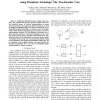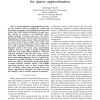15 search results - page 1 / 3 » Distributed Successive Approximation Coding using Broadcast ... |
CORR
2010
Springer
13 years 5 months ago
2010
Springer
Abstract-- Traditional distributed source coding rarely considers the possible link between separate encoders. However, the broadcast nature of wireless communication in sensor net...
TCOM
2010
13 years 3 months ago
2010
—In this paper, we consider cross-layer optimization in wireless networks with wireless broadcast advantage, focusing on the problem of distributed scheduling of broadcast links....
TWC
2008
13 years 4 months ago
2008
Conventional hybrid automatic retransmission request (HARQ) is usually used to maximize throughput. However, high throughput is achieved at the expense of high latency. We study a...
CISS
2008
IEEE
13 years 11 months ago
2008
IEEE
—Beyond signal processing applications, frames are also powerful tools for modeling the sensing and information processing of many biological and man-made systems that exhibit in...
ICASSP
2011
IEEE
12 years 8 months ago
2011
IEEE
We generalize the concept of multiuser peer-to-peer (MUP2P) relay networks to that of a multi-group multicasting (MGM) relay network where each source may broadcast its message to...


